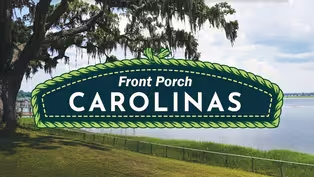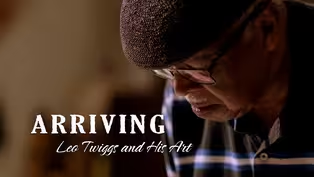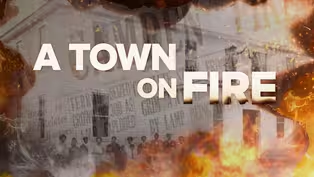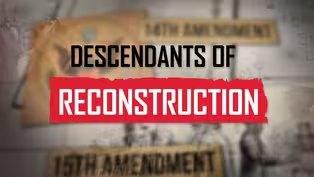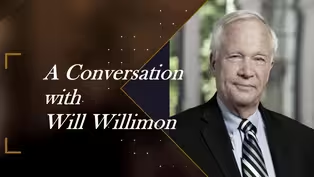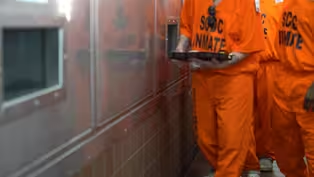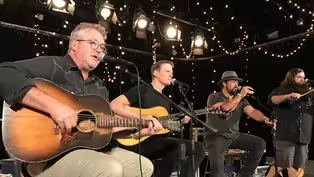
Weathering The Flood: South Carolina 10 Years Later
Special | 26m 46sVideo has Closed Captions
Revisit the "thousand-year" flood of October 2015.
Revisit the "thousand-year" flood of October 2015, when relentless rainfall devastated South Carolina. Ten years later, archival footage and expert insights reflect on the impact, recovery and resilience that continue to shape the state today.
Problems playing video? | Closed Captioning Feedback
Problems playing video? | Closed Captioning Feedback
SCETV Specials is a local public television program presented by SCETV
Support for this program is provided by The ETV Endowment of South Carolina.

Weathering The Flood: South Carolina 10 Years Later
Special | 26m 46sVideo has Closed Captions
Revisit the "thousand-year" flood of October 2015, when relentless rainfall devastated South Carolina. Ten years later, archival footage and expert insights reflect on the impact, recovery and resilience that continue to shape the state today.
Problems playing video? | Closed Captioning Feedback
How to Watch SCETV Specials
SCETV Specials is available to stream on pbs.org and the free PBS App, available on iPhone, Apple TV, Android TV, Android smartphones, Amazon Fire TV, Amazon Fire Tablet, Roku, Samsung Smart TV, and Vizio.
More from This Collection
Video has Closed Captions
Front Porch Carolinas takes viewers to important Civil Rights locations in the state. (27m 2s)
SC On Display: The Murals of Rock Hill
Video has Closed Captions
"'The Murals of Rock Hill'' spotlights this vibrant art community. (26m 46s)
Graceball: The Story of Bobby Richardson
Video has Closed Captions
At nineteen years-old, Bobby Richardson, became the starting second baseman for the Yankees. (54m 51s)
Arriving: Leo Twiggs and His Art
Video has Closed Captions
Dr. Leo Twiggs is an artist and educator in South Carolina. (56m 46s)
Video has Closed Captions
The Cleveland School fire of 1923 influenced building and fire codes nationwide. (56m 46s)
Video has Closed Captions
Explore the relationship between Reconstruction and African American Life. (56m 46s)
Video has Closed Captions
Part two continues the examination of the life of Cecil Williams. (56m 46s)
Video has Closed Captions
Explore the life of acclaimed civil rights photographer, Cecil J. Williams. (57m)
A Conversation With Will Willimon
Video has Closed Captions
William Willimon is an American theologian and bishop in the United Methodist Church. (27m 46s)
Carolina Country with Patrick Davis & Friends
Video has Closed Captions
Carolina Country with Patrick Davis & Friends. (58m 39s)
Providing Support for PBS.org
Learn Moreabout PBS online sponsorshipKelly Liggett> It was just, it was like a warzone.
It was crazy.
♪ Operator> 9-1-1, what's your emergency?
Caller> Water is about to start coming in my house.
Caller #2> Man, the car... is about to go underwater.
I mean, it's already in the water.
Caller #3> I called earlier, the water is rising.
Christy Hall> This, event that there was no escaping it, if you were caught in it.
♪ Fmr.
Mayor Benjamin> There was no match for 11 trillion gallons of water over a short period of time.
Laytan Cox> And it was moving cars and, it was moving fast.
Fmr.
Mayor Benjamin> People telling us they could hear the sounds of the dams popping.
Zack Hudson> It was awful.
It was like a river with rapids.
Christy> The DOT employee that got washed away in a vehicle.
Laytan> It never occurred to me in Columbia we would have it so bad.
Zack> I mean, we saw the forecast and the radar, but, nobody really expected, what was coming.
♪ ♪ > I'm SCETV Chief Meteorologist Tim Miller.
The early morning hours of October 4th, 2015 will be viewed as a life changing day for communities across the state of South Carolina.
Overwhelming rainfall resulted in the loss of life for 19 individuals.
Severely damaged homes and businesses, broken dams.
The closure of major roads and some bridges permanently closed, as well as the failure of water systems and the loss of electrical power.
What is known as the "thousand-year flood" that brought heavy rainfall and massive flooding, caused citizens throughout South Carolina from all walks of life to band together and weather through the days of devastation.
♪ > The devastation that... happened to the city was unlike anything probably, since General Sherman, marched through Columbia in 1865.
It was a very dark moment that began to illuminate the, the incredible goodness of the people of Columbia, South Carolina.
And I... count it a real privilege to have have had the opportunity to serve at that moment in time.
This levee, wall... collapses as we're watching it on TV.
And the water rushes out and this is a primary drinking source, for all of downtown, our hospitals and university, Fort Jackson.
And literally the fire department ferrying water from east Columbia ponds, to our primary, water system here to... continue to serve the city.
Our staff making the quick decision to build redundant systems to pump water from our rivers into the canal while watching the National Guard... and the amazing men of our military, bringing helicopters and dropping boulders to... begin to stop the river.
A temporary dam that holds to this day, as we've worked closely with, both Republican and Democratic administrations, to get, this dam repaired and they've been... both been wonderful to work with.
♪ > We're working to help the city shore up this diversion canal because this canal is what supplies water to the city of Columbia.
So we're trying to shore it up so they can get the water level back up high enough to, hit the, intakes for the water system.
Immediately, the impact, would be at least 300,000 citizens of Columbia without water.
And currently there... currently there are citizens without water because there's not enough water going into the intakes.
But if we lose this dike it will shut down the entire water system.
It is a potential threat that we could lose this canal, lose the dike, and then... the canal won't be able to hold the water, which will get it into the intakes.
So we're dropping, we have about 300 bags that have... some bags have sand, some bags have gravel or rock, stone that we're putting in place.
We're a secondary effort to what the city and its contractors are doing.
They're trying, they're in the process of building a stone bridge or dam across the canal.
What the National Guard is doing, is then placing the sand and stone to protect the canal wall, as they put in that bridge or put in that dam.
So we'll drop approximately 300 bags.
Each bag is... approximately 3,000 pounds each.
We started this, this mission yesterday.
We've been working all day, today.
We intend to keep operating until we get all of these bags in place, or we're directed, to work somewhere else to shore up the canal.
So morale's high.
Everybody's working real well together.
The National Guard, the City of Columbia, the contractors, the Columbia Police Department, supporting as well.
Very, very good effort.
Morale's high.
> In the last few days in Central, we've seen people that have been rescued from their homes that have come into Red Cross shelters, wet and afraid.
And the Red Cross has been there.
We've been there with a blanket and a big Red Cross hug.
There are people stranded in Williamsburg County, that don't have water and food.
And thanks to our partners, our government partners, we've been able to get Red Cross supplies and people in with the State Guard.
> Our goal is to make sure that the resources are available.
Our goal is to make sure that the safety is there.
And our goal is to make sure that we recover and we come out of this stronger than we started.
I have no doubt, that South Carolina is stronger today than we were yesterday.
I have no doubt that South Carolina will be stronger next week than we are this week.
But what I want everyone to remember is this is a time of faith.
This is a time of strength.
And this is a time of taking care of each other, and neighbors taking care of neighbors.
And if we do that, we will come out of this better than we had before.
Fmr.
Mayor Benjamin> And as a result of learning, from 2015, we're that much more prepared.
We have infrastructure, literally, infrastructure that normally would have been placed on the ground is elevated to make sure it's protected from flooding events.
We've done a number of... of improvements that not only create more resilient infrastructure, but also redundant systems.
If one fails, another one kicks in.
The really thoughtful way of using municipal financing, municipal infrastructure to prepare for the future.
I feel good that the city is in a... a great place, and in a very rapidly changing world.
Probably the greatest lesson I learned, as a leader at that time was the importance of transparent leadership.
I received information every single day from our city staff on exactly what was happening in the city.
And I remember standing at a press conference and sharing bits and pieces, and then deciding, there's some people who are wholly displaced from their homes.
There's some people who were receiving information on Twitter, some from network news, some on radio, some by word of mouth.
And decided that, at that moment, it was probably important just to share everything I had every single day on every medium that we could.
And that level of transparency and sharing that information, I think, built a certain level of trust with our citizens.
And after the fact, really turned into a wonderful opportunity to show people how government could work for them.
♪ Tim> One Midlands family, waking up to the devastation of fast moving waters never dreamed that their home would become ground zero, with five feet of water flowing right into their home.
♪ Kelly> Well, that night... went to bed not thinking anything, thinking all the rain was going to be in the upstate and nothing really bad was going to happen here.
So, someone stopped at that stop sign and just kept the lights on, and I was like, "this is weird."
They weren't flashing or anything.
And I kind of looked out the window and he turned and I saw him stop right before the bridge, and I'm like, "that's weird."
So, I went into the living room and looked, and I could just see water just gushing over the bridge and just like a huge... puddle of water right by our neighbors, the Price's and the Chase's house.
So it's like, "Oh my gosh, look at all that water."
Go wake up Kate.
I'm like, "Kate we need to find your rain boots."
And, you know, just kind of get up and going.
And at that time, more and more water started coming up, and I was like, "We got to get out of the house.
Our house is flooding."
So, calling my neighbors next door, trying to wake them up, calling Laytan.
> I woke up at midnight and it was really pouring.
And I was sleeping in my den because I had the TV in there, and I just felt safer being in the den, that night.
And I woke up to the Liggetts... I had some missed phone calls and they were beating on the door.
And I went to the door and they had their dog and they had Kate.
And that's when we realized we were in trouble.
It was moving cars and, it was moving fast.
So at this point, we're realizing that people on this side of the street have no idea.
So we're knocking on doors, making phone calls, waking people up.
And literally, they had no idea.
One elderly lady... they had to break in her house and carry her out.
So my house became the place where everybody came.
Kelly> And so I go, and I'm in full blown rescue mode.
At that time, the sun's coming up because at this point it was like about 5:30 or so.
Water was everywhere, I was throwing clothes on the bed.
Just anything that I thought that I could save or, you know, protect from- And furniture was floating around, everything, it was crazy.
> We saw the forecast and the radar, but, nobody really expected what was coming.
We didn't really have any idea what was going on until our neighbor called at six in the morning on a Sunday morning.
At that point, we realized, something was going on.
So we woke up and, kind of made our way down here to Quail Lane, and... had no idea what we would find.
It was, it was awful.
The waters were... were rushing down Portobello, next door.
It was like a river with rapids.
Kelly> I just remember... walking out, or I tried to get out of that door and more water was gushing, and there was a policeman right up here, and, I had to go to my laundry room window and open the window and say, "Can somebody help me?"
I wasn't crying, I wasn't panicking, I was just like, "I kind of need help to get out."
And so the policeman came and, you know, we walked out and, walked, you know, just across the street and you were fine.
Zack> I remember riding down the middle of what would have been Portobello, Portobello and... we just ran into something, it sounded like glass cracking.
(glass shattering) The motor of the boat we were in was hitting a car underneath the, the road.
It had drifted, drifted out into the middle of the road.
Kelly> It was just, it was like a warzone.
It was crazy.
There were cars everywhere.
There was already a truck out and people were... getting ready to take things out of my house that could not be salvaged.
Zack> So I had a three-month-old and a three-year-old at home.
Thank goodness, my house is elevated.
So, I knew my wife and my kids were safe, and, our neighbors needed help.
It was really amazing.
I feel like our neighborhood, nobody really skipped a beat or thought, they just, everybody jumped in and did what they could to help.
It was kind of wild.
I mean, there was a police presence, but, so many people were calling.
Everyone needed help.
I felt like the information was almost a little delayed.
So, we were here in real time just going door to door.
When we found folks that needed help, we would help them.
When we felt, our immediate neighbors were in safe hands and most people had gotten out and there were enough bodies here to help, We made our way to the backside of our neighborhood, a street called Downing.
And I just remember going, we had to duck, the water was so high, we had to duck to go under power lines.
In the boat, it was an eerie feeling but we made our way back there, and found some more folks that needed help.
We were able to, to pull our boat up to a second story window.
It was a woman that was bedridden.
The water was up to the second story, and it was a group of us, four of us.
Got a stretcher, we were able to get her out the window onto the roof, where we were able to load her into the boat.
But... again, it was just, everyone was doing what they could to help their neighbor.
It was, catastrophic, but good to see everyone jumping in, and doing what they could.
Kelly> Your dad wore that during the flood when he was riding around on the boat.
Kate> Yes.
<Voice off screen> He wanted to stay safe but he was out, he was out helping and... helping your friends and your neighbors.
And that sort of has become a little bit iconic with him, right?
The orange life preserver.
♪ Laytan> Well, at this point, it's so chaotic that I'm not realizing that this is all over Columbia.
I'm just thinking it's our neighborhood.
And we were just working so hard trying to help the neighbors and by 7 a.m.
the boats started coming and pulling people out of houses.
And that's when, you know, I was calling people from other neighborhoods thinking, they weren't having this going on and they were having the same problems.
So, it was just a chaotic day.
I mean, we worked... just round the clock.
And my house, fortunately, did not have any flooding and I never lost electricity, so I was able to, throughout the week, ice down drinks, have food.
We were able to like, get restaurants to come in and set things up in people's yards to feed people.
You cannot believe the help that came in, to help people with their houses.
Kelly> I'm just thankful that... like I say, getting out, Kate was as brave as she was and it wasn't a traumatic time for her.
♪ And just that we had a great place, a place, another home that we could stay in that felt like home for those nine months.
It could have been a lot worse.
So God was looking out for us, I truly believe.
♪ Tim> The City of Columbia Emergency Communications took about 40,000 calls in four days.
Flood waters traveled downstream across nearly half the state of South Carolina and caused devastation to agriculture, destruction of neighborhoods in the Midlands and several other counties, including Clarendon, Berkeley, Charleston, Georgetown, and Horry Counties.
When we talk about the "thousand-year flood," what if I told you something incredible, 11 trillion gallons of water falling from the sky.
That is just hard to fathom.
But that's exactly what happened.
Senior Meteorologist Meagan Borowski is here now to talk about how this can actually take place from an atmospheric standpoint and the standpoint of predicting this from a meteorologist.
Here's Meagan Borowski.
> We've been throwing around the phrase "one in a thousand-year event."
Well, what exactly are the ingredients that we need to actually play into something like that?
Well, you can kind of see it in our archive satellite imagery from early October in 2015.
We have a hurricane to the south and east near Bermuda, tracking toward Bermuda and we also see just a little bit of a disturbance over South Carolina.
Let's dive into that just a little bit more.
So our hurricane, Hurricane Joaquin was a major hurricane.
And it was hundreds of miles off the shoreline of the southeast coastline.
But nonetheless, it was close enough to help to funnel in tropical moisture, an "atmospheric river" so to speak, thanks to counterclockwise circulation around the storm itself, dragging in a deep column of moisture to the state.
And that moisture was available for an upper level low over the, northeastern Georgia or eastern Georgia, to help to create days worth of steady rainfall, heavy rainfall at times.
We also had a trough, paralleling the coastline of the southeast, also helping to lift that moist air mass and create those days worth of heavy showers and thunderstorms.
All of these ingredients kind of worked with each other to create the flooding event that unfortunately we experienced ten years ago.
So let's talk about the actual rainfall totals that we saw across the state.
A couple of numbers here, of course, this is not an exhaustive list.
Mount Pleasant tops the list here with over 27 inches of rainfall.
That's almost about half that we would expect over the entire year, we got over just the course of several days.
Georgetown, almost two feet.
Gill's Creek, over 21 inches.
Of course, Gill's Creek was 19 feet in the flood stage.
And we just go down the list, we can see over a foot of rain in many spots, many urban areas.
And of course, those urban areas don't have a whole lot of places where the water can go.
It goes, on pavement down into our storm drains and of course, into local waterways, which led to widespread flooding along those waterways.
Let's talk a second about how much flash flooding do we need to create catastrophic damage across our area?
Of course, we saw those images coming on in as the event unfolded, but you might be surprised as to how little rainfall you actually need to sweep away a person.
Only six inches of rainfall, or flash flooding, you need to sweep a person off their feet.
Just a foot of rainfall to sweep a sedan away.
And just over 18 inches of water to sweep a pickup truck away.
And, of course, we saw feet worth of flooding and those images of damage coming in.
So that set the stage as we saw, that satellite imagery of the hurricane and the atmospheric river, setting the stage for a flash flooding event across the state of South Carolina.
Tim> Roadways across South Carolina were impassable, washed out, and some communities completely cut off for a time period.
Devastation in the flood of 2015, SCDOT reported, some 900 sites were closed across the state.
> That particular storm, completely changed the way the state DOT looks at its emergency operations.
We moved from just being siloed in individual county operations into one big, large workforce that was moving in unison, with a lot of agility all across the state, in response to that catastrophic event.
I remember, Lower Richland in particular, you know, was basically cut off for a period of time and... making sure that the state DOT- Our primary responsibility is to, provide that connection, provide that access, and making sure that we could identify and restore and communicate which roads were open, more so, than which roads were closed.
And that was a really dramatic change for us at the state level.
But in that particular storm, it became evident that we really needed to be talking about what was open.
So that, not only... the public knew which way they could come in and out of an area at a later date, but certainly on the front end, so that the emergency response teams would know, you know, these routes are open, here's how you can get into service these areas and execute your resource and response and recovery operations.
I mentioned Lower Richland, earlier, I distinctly remember driving through the community, and this was after the floodwaters had receded.
But I distinctly remember driving through the community and you could see the water stain on the trees and the leaves on the trees and just how high that was.
And it just really, really, you know, hit home that... this event... that there was no escaping it if you were caught in it.
There were 19 people that died during that particular storm.
One of which, was a DOT employee that got washed away in a vehicle.
You know, trying to do his job during the event and, you know, trying to locate him, was something that I was personally involved in not physically, you know, me out looking for him, but certainly in contact with the first responders and making sure that we had reached out to the family and everything, to try to do everything we could to find, you know, our lost colleague.
But like I said, it was it was just so much bigger than that, because it wasn't long after that that you started to hear a lot more additional stories about everybody else.
One of the things this, the 2015 storms taught us was to, you know, really look at the, the weather data and try to do some forecasting on roads that may overtop and things like that.
So that was another change that came about because of the 2015 floods.
We really were able to, within two months, have the overwhelming majority of the roads reopened and repaired.
My entire career, we had never detoured an interstate.
But in that particular case, we had to detour, put in a 100 mile long detour.
Because we needed to close I-95 to safen up the bridge there, in Clarendon County.
And so, you know, those kind of unprecedented things that happened, really kind of have helped position the DOT to be a much more agile agency today when it comes to planning, preparing, responding and recovering to a natural disaster.
Tim> The historic floods of 2015 left an indelible mark on South Carolina changing lives, reshaping communities, and testing the resilience of families and emergency agencies alike.
For me, as a meteorologist, this devastating flood deepened my commitment to keeping you safe and informed.
Natural disasters like floods can strike without warning, but there are steps we all can take now to prepare for the unexpected.
Have an emergency communication plan in place.
Write down critical phone numbers, don't just rely on your cell phone.
Sign up for emergency alerts from your local and state agencies.
And start building an emergency supply kit, little by little, if needed.
You can find more tips and resources at SCEMD.org I'm South Carolina ETV Chief Meteorologist Tim Miller.
Thank you for being with us, as we looked back on Weathering The Floods South Carolina Ten Years Later.
We appreciate you joining us to remember, reflect, and look ahead.
Stay safe and good night.
♪ ♪ ♪ ♪ ♪ ♪ ♪ ♪ ♪ ♪ ♪ ♪ ♪ ♪ ♪ ♪ ♪ ♪ ♪ ♪ ♪ ♪ ♪ ♪
Support for PBS provided by:
SCETV Specials is a local public television program presented by SCETV
Support for this program is provided by The ETV Endowment of South Carolina.
